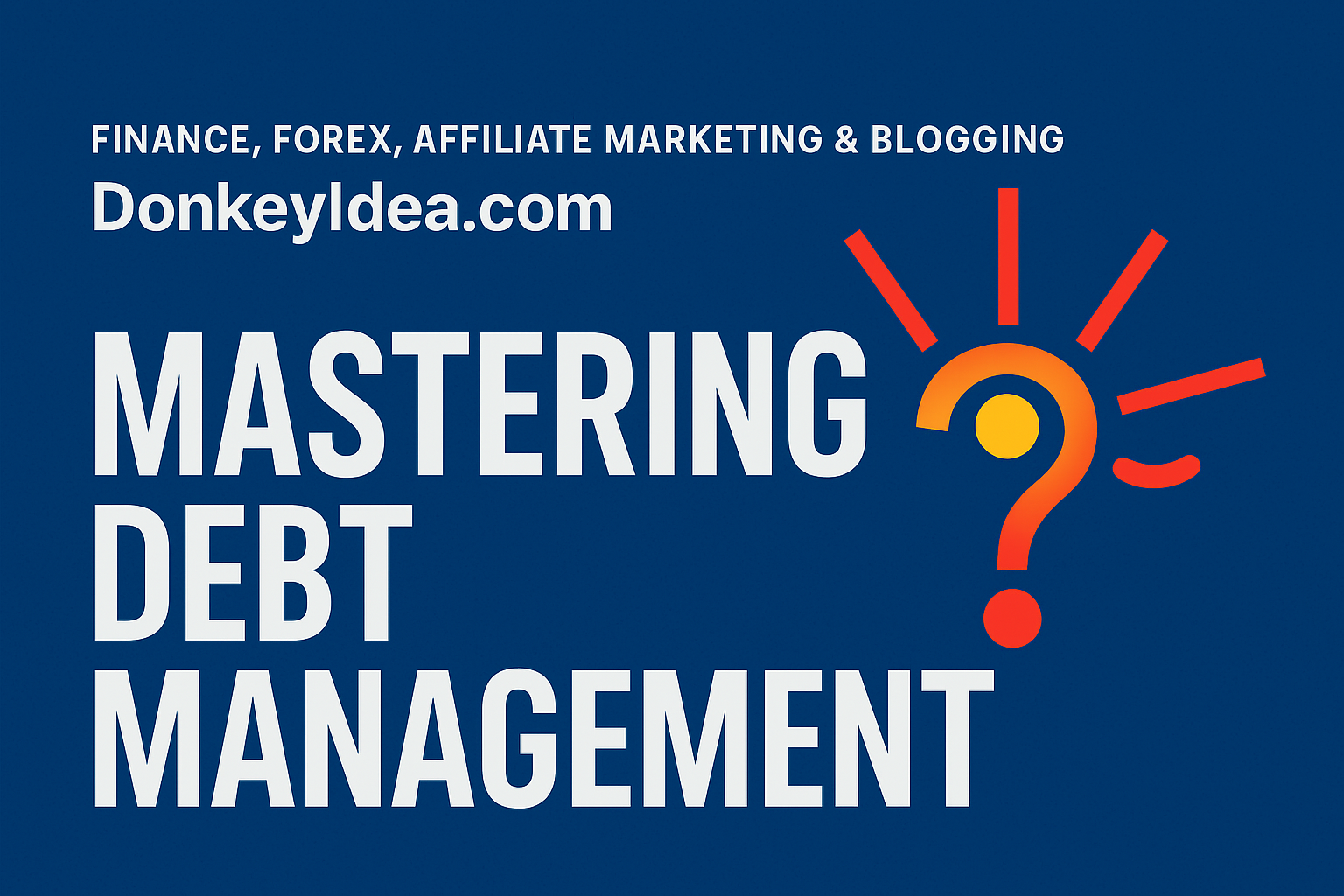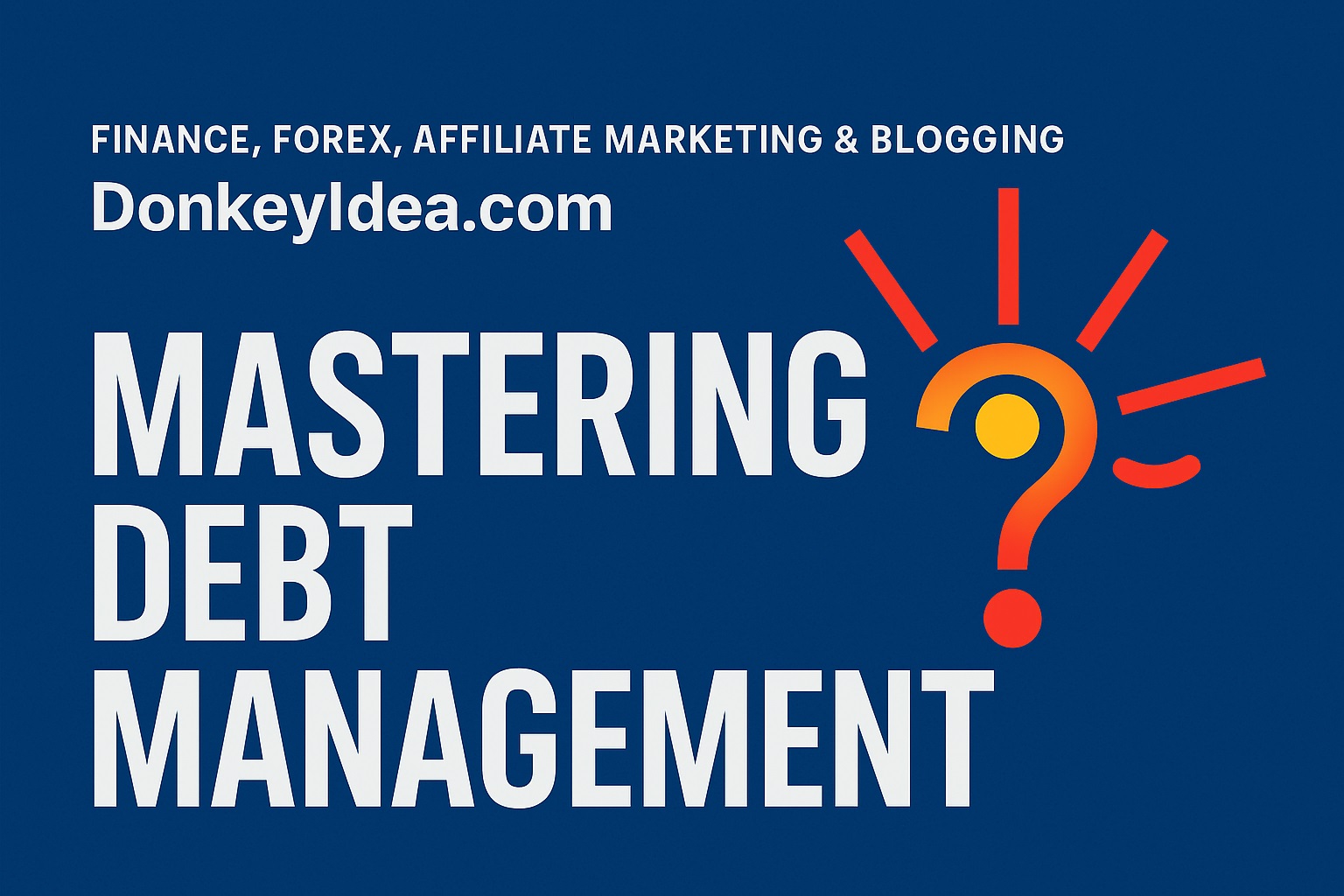Learn how to create a debt management plan for beginners and take control of your finances today. Discover useful tips and strategies that work!
Managing debt can feel overwhelming, especially for beginners. Understanding how to create a debt management plan for beginners is a crucial step towards financial freedom. A debt management plan helps you organize your payments and create a roadmap to pay off what you owe. Financial planning is essential because it gives you control over your money instead of letting it control you. By learning how to manage your debt effectively, you can reduce stress and build a more secure future.
When you have a solid plan in place, financial worries become less daunting. You can focus on your goals and dreams rather than being buried under bills. This blog post will guide you through the process of how to create a debt management plan for beginners. The benefits of understanding and applying these strategies can lead to a life free of financial burden.
Loan management software can be a great ally in your journey to managing debt. These tools help you keep track of your loans, payments, and due dates. For more information, check out this article on [Loan Management Software](https://www.donkeyidea.com/7-powerful-loan-management-software-solutions-to-simplify-your-finances/).
In This Post, You’ll Learn:
- How to create a realistic budget you can stick to
- Where your hidden spending leaks are
- Tools that make money management easy
Understanding Your Debt
What it is: Knowing exactly how much you owe is the first step. This includes all your loans, credit cards, and other debts.
Why it matters: If you don’t know your total debt, you can’t create a plan to pay it off. It’s like trying to find your way without a map.
How to apply it: Write down all your debts, their interest rates, and monthly payments. This will give you a clear picture.
Pro Tip: Use a simple spreadsheet or an app to keep track of everything.
Create a Zero-Based Budget
What it is: A zero-based budget means every dollar you earn has a purpose. Your income minus your expenses equals zero.
Why it works: This method helps you see where your money goes and eliminates unnecessary spending.
How to do it: List your monthly income and expenses. Adjust your spending until your budget balances.
Pro Tip: Review your budget every month to adjust for any changes.
Automate Your Savings
Why this helps: Automating your savings ensures that you’re setting money aside without thinking about it.
How to set it up: Most banks allow you to create automatic transfers from your checking to your savings account each month.
Seek Professional Help
What it is: Sometimes, getting help from a financial advisor can provide you with the guidance you need.
Why it matters: A professional can help you create a personalized debt management plan that suits your financial situation.
How to apply it: Research local financial advisors or consider online consultations.
Pro Tip: Look for advisors who specialize in debt management.
Loan management tools for financial institutions can also facilitate your journey toward debt management. These tools help streamline the lending process and keep track of payments. For more details, check out this article on [loan management tools for financial institutions](https://www.donkeyidea.com/7-powerful-loan-management-tools-for-financial-institutions-that-simplify-processes/).
When I started tracking every expense, I realized how much I was spending on coffee alone. Just switching to homemade coffee saved me over $50 a month!
Frequently Asked Questions
1. What is a debt management plan?
A debt management plan is a structured program to help individuals manage their debt. It involves creating a budget, negotiating with creditors, and making regular payments. For example, if you have credit card debt, a debt management plan can help you consolidate payments into one monthly amount, making it easier to manage.
2. Who can benefit from a debt management plan?
Anyone struggling with debt can benefit from a debt management plan. Whether you have student loans, credit card debt, or personal loans, a plan can help you take control. For instance, a recent graduate with student loans may find a plan invaluable for managing payments and avoiding default.
3. How do I start creating a debt management plan?
Start by listing all your debts and their details. Then, create a budget that accommodates your payments. You might also consider consulting a financial advisor for personalized guidance. A simple first step could be using a budgeting app to track your expenses.
4. Is it necessary to hire a credit counseling service?
It is not necessary, but it can be beneficial. A credit counselor can offer professional advice and help you negotiate with creditors. For example, they might help you set up a payment plan that lowers your interest rates.
5. Can I negotiate with creditors on my own?
Yes, you can negotiate with creditors on your own. Many creditors are willing to work with you to set up a payment plan or reduce your interest rate. It’s helpful to approach them with a clear plan and be honest about your financial situation.
Recap / Final Thoughts
Mastering your money isn’t about restriction—it’s about intention. Start by applying just one or two of these strategies today. Small steps lead to big results. Remember, managing debt is a journey, and every step counts.
Conclusion
Understanding how to create a debt management plan for beginners is essential for financial well-being. By taking control of your budget and reducing debt, you empower yourself. Stay informed and keep improving your financial strategies, and watch as your debt decreases and your confidence grows.
Remember, every journey starts with a single step. Don’t hesitate to take that first step towards financial freedom. You got this!
Recommended Next Steps
Now that you know how to create a debt management plan for beginners, consider these next steps:
- Start tracking your expenses today.
- Create a zero-based budget to see where your money goes.
- Look into loan management tools that can help simplify your process.
- Consult a financial advisor for personalized advice.
For more insights into forex trading, check out Website 1 and Website 2.
Expand Your Knowledge
- 📌 Financial Planning Tips & Strategies
- 📌 Budgeting Techniques
- 📌 Debt Management
- 📌 Insurance & Financial Security
- 📌 Loan Managing Solution
- 📌 Outsourcing & Finance
- 📌 Passive Income Ideas
- 📌 Saving and Investing
- 📌 ———————————-
- 📌 Affiliate Marketing
- 📌 Blogging
Start Trading Today
Ready to take your forex trading to the next level? Open an account with Exness, one of the most trusted platforms in the industry. 👉 Sign Up Now and start trading with confidence!
Exness stands out with ultra-low spreads for mini traders, instant withdrawals, and zero spread accounts for pro traders. Trusted since 2008, Exness offers lightning-fast execution, no hidden fees, and a secure, transparent trading environment—giving you the edge you need to succeed. 🚀 Join now and trade smarter!
Watch this helpful video to better understand how to create a debt management plan for beginners:
Note: The video above is embedded from YouTube and is the property of its original creator. We do not own or take responsibility for the content or opinions expressed in the video.
Creating a Debt Management Plan (DMP) is an essential step towards achieving financial stability and freedom, especially if you find yourself in debt. The process begins with a thorough assessment of your current financial situation. Start by listing all your debts, including credit cards, personal loans, student loans, auto loans, and any other debts like medical bills or unpaid taxes. Make sure to include their respective balances, interest rates, and minimum payments. Next, calculate your total debt and monthly obligations to get a clear picture of your financial burden. Afterward, review your income sources and categorize your monthly expenses into essential and non-essential items. This comprehensive overview will help you understand where you stand financially and will be the foundation for setting realistic goals.
Once you have a clear understanding of your financial situation, it’s time to set achievable financial goals. Short-term goals could include building an emergency fund of at least $1,000 and aiming for monthly debt reduction targets. Long-term goals should focus on establishing a realistic timeline for becoming debt-free and setting financial milestones, such as paying off specific debts. Creating a budget is another significant step; allocate funds for essential fixed expenses, identify areas to cut back on non-essential spending, and ensure you plan for your debt repayments. Additionally, consider various debt repayment strategies like the debt snowball method or the debt avalanche method to make your repayment process more efficient. Don’t hesitate to negotiate with creditors for lower interest rates or explore debt consolidation options to simplify your payments. Throughout this journey, monitoring your progress and seeking professional help when needed can provide the support and motivation required to stay on track. Ultimately, developing healthy financial habits, such as setting up automatic payments and investing in financial literacy, will help you maintain discipline and work towards financial freedom.
In the realm of financial management, utilizing technology can enhance your operational efficiency, especially for microfinance institutions. Implementing loan tracking software for microfinance institutions can streamline processes such as tracking repayments, managing loan disbursements, and monitoring borrower profiles. This software not only helps improve financial management but also enhances customer service by providing timely updates and insights into loan statuses. By leveraging such tools, microfinance institutions can manage their portfolios effectively while ensuring compliance with regulatory requirements.

